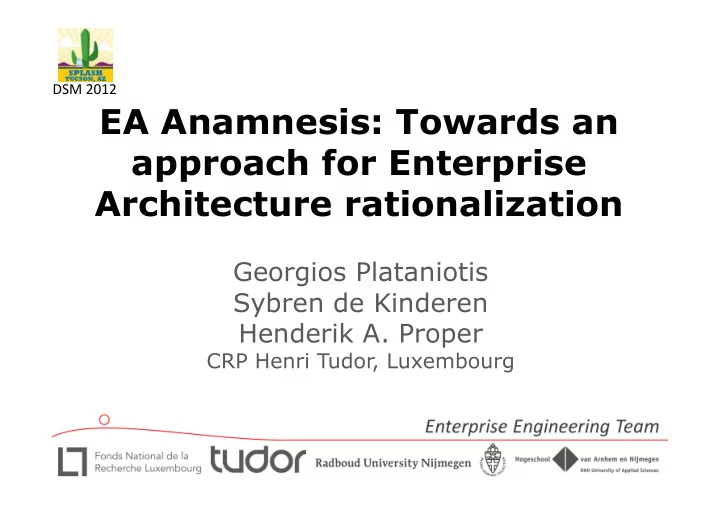

DSM ¡2012 ¡ EA Anamnesis: Towards an approach for Enterprise Architecture rationalization Georgios Plataniotis Sybren de Kinderen Henderik A. Proper CRP Henri Tudor, Luxembourg 1 ¡
Enterprise Architecture Ø A design that shows the coherence between products, processes, organization, information supply and IT infrastructure [11][5] 2 ¡
Modeling EA with ArchiMate Ø Open Group standard DSL for EA modeling [4] Ø Provides a layered view of the Enterprise: – Business, Application and Technology layer Ø Each layer is: – self contained – integrated with other layers Ø Captures design but not design rationale 3 ¡
Problem of EA Amnesia (1/2) Ø EA modeling languages capture what was done. Ø What about why? Ø Rationale and alternatives that original architect considered during design process are lost over time 4 ¡
Problem of EA Amnesia (2/2) Ø Lack of design rationale causes: – No justification of past decisions [6] – Design integrity issues (constraints from past are not taken into consideration) [15] – Limited understandability of existing Architecture [16] – Limited traceability to business requirements [16] 5 ¡
EA Anamnesis approach Ø Anamnesis ( ἀ νά µ νησις ) denotes memory, history Ø DSL that extends EA modeling languages Ø Reducing architectural knowledge gap by ex-post capturing decisions and their rationales Ø Grounded on Software Architecture rationale approaches [6,15,16,7,13] – Decision Representation Language [9] – Decision Dependency Trees [12] 6 ¡
EA Anamnesis metamodel Intra>Layer# Decision# Title# Criteria# EA#Issue# Maker# Solved#by# 1# Inter>Layer# 1..*# 1# 1# has# 1# influence# Dependent# 1..*# 1..*# 1..*# has# 0..*# 1# Decision# 1..*# addresses# EA#Decision# has# 1..*# 1# is#a# 1..*# Is#member#of# 0..*# 1..*# 1..*# 1..*# 1# AlternaGve# causes# reasons# Layer# Conforms#with# 1# 0..*# 1# Observed# Policy# RaGonale# Impact# 7 ¡
Illustrative example Ø ArchiSurance transformation intermediary Ø 2 architects (John, Bob) Ø John did and modeled the actual transformation Ø John, using EA Anamnesis, captured the rationale Ø Bob (a new hired EA Architect) uses EA Anamnesis to efficiently understand and justify the as-is architecture 8 ¡
B u s i n e s s ¡ A p p l ¡ i c a t ¡ i o n ¡ ArchiSurance ¡direct-‑to-‑customer ¡EA ¡model ¡ ¡ 9 ¡
B u s i n e s s ¡ A p p l ¡ i c a t ¡ i o n ¡ ArchiSurance ¡intermediary ¡EA ¡model ¡ ¡ 10 ¡
Decision Dependency Tree EAD*01* Add*insurance* broker* Environment* EAD*02* EAD*03* Remove*Car* New*customer* Insurance* Registra3on* Registra3on*Service* Service* EAD*04* EAD*10* Change*Func3on* New*Func3on*Create* Contrac3ng* Customized* * Insurance*Package* EAD*07* EAD*06* New*Business* Remove*Car* Interac3on*Customer* Insurance* Profile*Registra3on* Registra3on*Service* Business* EAD*08* EAD*09* EAD*10* Remove*Customer* New*Customer* New*Customer* Administra3on* Administra3on* Administra3on* Service* Service*Intermediary* Service*ArchiSurance* EAD*11* Alterna3ve* EAD*13* EAD*12* Remove*Customer* Upgrade*Customer* New*Customer* New*Customer* Administra3on* Administra3on* Administra3on* Administra3on* Applica3on* Applica3on* Applica3on* Service*Intermediary* Applica3on* 11 ¡
Decision Dependency Tree EAD*01* Add*insurance* broker* Environment* EAD*02* EAD*03* Remove*Car* New*customer* Insurance* Registra3on* Registra3on*Service* Service* EAD*04* EAD*10* Change*Func3on* New*Func3on*Create* Contrac3ng* Customized* * Insurance*Package* EAD*07* EAD*06* New*Business* Remove*Car* Interac3on*Customer* Insurance* Profile*Registra3on* Registra3on*Service* Business* EAD ¡13 ¡ EAD*08* EAD*09* EAD*10* Remove*Customer* Upgrade ¡Customer ¡ New*Customer* New*Customer* Administra3on* Administra3on* Administra3on* Service* Service*Intermediary* Service*ArchiSurance* Administra=on ¡ Applica=on ¡ EAD*11* Alterna3ve* EAD*13* EAD*12* Remove*Customer* Upgrade*Customer* New*Customer* New*Customer* Administra3on* Administra3on* Administra3on* Administra3on* Applica3on* Applica3on* Applica3on* Service*Intermediary* Applica3on* 12 ¡
13 ¡ EA ¡Decision ¡13 ¡table ¡
Summary Ø EA Anamnesis is a DSL that aims to play the role a Knowledge Management Based Decision Support System (KM- DSS) for EA Ø EA Anamnesis metamodel represents important rationalization and dependency details of EA decisions 14 ¡
Future work: – How we extend the metamodel to identify and capture decision making strategies ? (compensatory, non-compensatory, etc) – How can we support decision making during design process ( a-priori )? – Is the return of modeling effort of EA Anamnesis sufficient? 15 ¡
References [1] C. Coggins and J. Speigel. The methodology for business transformation v1.5: A practical approach to segment architecture. Journal of Enterprise Architecture, 2007. [2] J. Cummins and N. Doherty. The economics of insurance intermediaries. Journal of Risk and Insurance, 73(3):359{396, 2006. [3] S. De Kinderen, K. Gaaloul, and E. Proper. Integrating value modelling into archimate. In 3 rd International Conference on Exploring Service Science, pages 54{61. IEEE, 2012. [4] V. Haren. Archimate 2.0 Specication. Van Haren Publishing Series. Van Haren Publishing, 2012. [5] J. Hoogervorst. Enterprise architecture: Enabling integration, agility and change. International Journal of Cooperative Information Systems, 13(03):213{233, 2004. [6] A. Jansen and J. Bosch. Software architecture as a set of architectural design decisions. In Software Architecture, 2005. WICSA 2005. 5th Working IEEE/IFIP Conference on, pages 109{120. IEEE, 2005. [7] P. Kruchten. An ontology of architectural design decisions in software intensive systems. In 2 nd Groningen Workshop on Software Variability, pages 54{61, 2004. [8] M. Lankhorst. Enterprise architecture at work: Modelling, communication and analysis. Springer, 2009. [9] J. Lee. Extending the potts and bruns model for recording design rationale. In Software Engineering, 1991. Proceedings., 13th International Conference on, pages 114{125. IEEE, 1991. [10] P. Louridas and P. Loucopoulos. A generic model for reective design. ACM Transactions on Software Engineering and Methodology, 9(2):199{237, 2000. [11] M. Op't Land, E. Proper, M. Waage, J. Cloo, and C. Steghuis. Enterprise architecture: creating value by informed governance. Springer, 2008. [12] A. Ran and J. Kuusela. Design decision trees. In Proceedings of the 8th International Workshop on Software Specication and Design, page 172. IEEE Computer Society, 1996. [13] J. Savolainen. Tools for design rationale documentation in the development of a product family. In Position Paper Proceedings of 1st Working IFIP Conference on Software Architecture, San Antonio, Texas, 1999. [14] A. Tang, M. Babar, I. Gorton, and J. Han. A survey of architecture design rationale. Journal of systems and software, 79(12):1792{1804, 2006. [15] A. Tang, Y. Jin, and J. Han. A rationale-based architecture model for design traceability and reasoning. Journal of Systems and Software, 80(6):918{934, 2007. [16] J. Tyree and A. Akerman. Architecture decisions: Demystifying architecture. Software, IEEE, 22(2):19{27, 2005. 16 ¡
Thank you for your attention Georgios Plataniotis, MSc PhD Candidate CRP Henri Tudor, Luxembourg georgios.plataniotis@tudor.lu 17 ¡
Recommend
More recommend